by Cameron Martindell, offyonder.com
Hi travelers! Cameron Martindell here from the ATTA’s Storytelling team. Namibia will be the trip of a lifetime for many of the 2013 ATWS delegates and while planning ahead (with some flexibility built in) and an open heart are probably at the top of the list to make this the best trip possible, some gear may come in handy as well. I was fortunate to join and document Chris Doyle on his scouting trip to Namibia in February (which on average is slightly warmer and wetter than October when the summit will take place) and in the process I picked up some gear to test.
Namibia is not “Africa Hot” as some may perceive, especially not in October, the end of their winter/dry season. In the far north of the country (closest to the equator) the average temperature is in the high 70’s F (max in the low 90’s F) and the lowest lows across the country are only in the upper 50’s F. It is however very sunny and for your pre-, post- and days of adventure plan to keep covered and/or bring suntan lotion. I had a bottle of Sunology sunblock ($15/3oz - sunology.com), a chemical-free brand. It’s a little thick, but worked great. Bugs and insects are not generally a problem in Namibia but mosquitos and the like do exist. Bugs were most noticeable in the Caprivi (northern Namibia) at sunset. I tried out some bug deterrent clothing from Columbia, ExOfficio and Tilley (they’re not just hats!) and without spraying or gooping on any bug repellant, I feel like I had the least amount of bug problems as compared to the rest of our group that used some sort of bug spray. Here’s a rundown from top to bottom:
Head/Neck Wear
Tilley LTM6IS AIRFLO Hat with Insect Shield
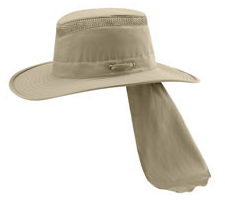 While in the field, a hat is a must and this hat was perfect. The venting at the top kept the hat from being too warm, a broad rim provided plenty of shade even in the mid morning and late afternoon when the sun was lower on the horizon and the neck protector was easy to deploy and stow as needed. The neck protector has Velcro tabs to wrap it around your neck and bind it below your chin to ensure total neck coverage. There’s also an adjustable and stowable chin strap for breezy days or boat rides. I never had any bug problems around my face and neck thanks to the Insect Shield technology built into the fabric. The hat collapses to pack flat in your luggage if you don’t feel like wearing it on the plane to Namibia. Finally, Tilley Endurables has one of the best product guarantees out there that is worth consideration when pondering over the pricetag. $95/tilley.com
While in the field, a hat is a must and this hat was perfect. The venting at the top kept the hat from being too warm, a broad rim provided plenty of shade even in the mid morning and late afternoon when the sun was lower on the horizon and the neck protector was easy to deploy and stow as needed. The neck protector has Velcro tabs to wrap it around your neck and bind it below your chin to ensure total neck coverage. There’s also an adjustable and stowable chin strap for breezy days or boat rides. I never had any bug problems around my face and neck thanks to the Insect Shield technology built into the fabric. The hat collapses to pack flat in your luggage if you don’t feel like wearing it on the plane to Namibia. Finally, Tilley Endurables has one of the best product guarantees out there that is worth consideration when pondering over the pricetag. $95/tilley.com
Revo Sunglasses
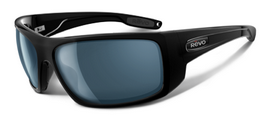 Like a hat, nay, even more important than a hat is good eye protection. Glare from water, light colored reflective surfaces and even gusty wind blasts laden with sand are just a few of the threats for your eyes. I traveled with two pairs of sunglasses, both from Revo. My favorite, The Headway, is a full-wrap coverage frame that provided the most protection possible short of wearing goggles. The lenses are sharp so you’ll spot every wildlife viewing opportunity possible. They also come with a leash and float buoy to keep you from losing them during more vigorous and/or water-bound activities, like dodging a charging hippo (it’s not recommended getting in that situation in the first place). $209/revo.com
Like a hat, nay, even more important than a hat is good eye protection. Glare from water, light colored reflective surfaces and even gusty wind blasts laden with sand are just a few of the threats for your eyes. I traveled with two pairs of sunglasses, both from Revo. My favorite, The Headway, is a full-wrap coverage frame that provided the most protection possible short of wearing goggles. The lenses are sharp so you’ll spot every wildlife viewing opportunity possible. They also come with a leash and float buoy to keep you from losing them during more vigorous and/or water-bound activities, like dodging a charging hippo (it’s not recommended getting in that situation in the first place). $209/revo.com
The Buff with Insect Shield
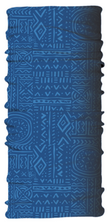 Neck gaiters are incredibly versatile and work well with or without a hat. Using the same Insect Shield technology as Tilley, there are a number of Buff designs to fend off bugs and UV to keep you protected while on safari. The other beauty is to soak your Buff with water and put that on your neck to keep cool. $27/buffusa.com
Neck gaiters are incredibly versatile and work well with or without a hat. Using the same Insect Shield technology as Tilley, there are a number of Buff designs to fend off bugs and UV to keep you protected while on safari. The other beauty is to soak your Buff with water and put that on your neck to keep cool. $27/buffusa.com
Columbia Freezer Zero Bandana & Neck Gaiter
While these items don’t have any sort of bug repellency, they do have a very cool (literally) technology from Columbia called Omni-Freeze Zero. Little dots in the fabric absorb heat when they get wet (water or sweat) to keep you cool. Fellow chemistry geeks will immediately recognize this simply as an endothermic reaction and it really works. Again, Namibia in October may not be hot enough to warrant this, but if you overheat easily, this may be for you. Omni-Freeze Zero also comes in shirts, shorts and shoes. $28-30/columbia.com
Body Garb
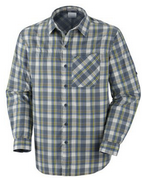 Columbia Sportswear makes a whole range of garb appropriate for your trip to Namibia. Everything of theirs I took included the Insect Blocker technology which, as far as I can tell, works just as well as the anti-bug technology used by previously mentioned brands. Columbia however also incorporates Omni-Wick, a moisture transfer technology to keep you dry and Omni-Shade, a UV blocking technology to protect you from the sun. Ultimately it will boil down to finding a style and fit you like. From Columbia’s Insect Blocker series I wore and liked the Plaid Long Sleeve Shirt ($85), Cargo Pant ($80) and for cooler buggy evenings the Full Zip Hoodie ($90).
Columbia Sportswear makes a whole range of garb appropriate for your trip to Namibia. Everything of theirs I took included the Insect Blocker technology which, as far as I can tell, works just as well as the anti-bug technology used by previously mentioned brands. Columbia however also incorporates Omni-Wick, a moisture transfer technology to keep you dry and Omni-Shade, a UV blocking technology to protect you from the sun. Ultimately it will boil down to finding a style and fit you like. From Columbia’s Insect Blocker series I wore and liked the Plaid Long Sleeve Shirt ($85), Cargo Pant ($80) and for cooler buggy evenings the Full Zip Hoodie ($90).
My ExOfficio kit is a little older but basically I had the BugsAway Baja Long Sleeve Shirt ($99) and an older version of the Nio Amphi Pant ($80) that had a built in mesh brief which they don’t seem to make anymore.
Footwear
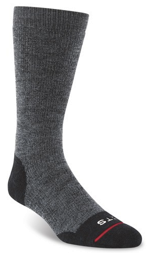 I never thought socks made such a big difference, but they do. For lounging around the house it’s probably not that big of a deal. But when you are active and on your feet jumping in and out of safari vehicles, walking and tracking wildlife overland and fording rivers, even skiing (though, that’s a stretch for Namibia) a good fitting pair of socks is key. I’ve become a fan of a few brands of socks. First and foremost, Fits Socks do as their name implies. A super deep heel cup is just one aspect of the three part Full Contact Fit technology. They have a wide range of styles available, so you’ll have to browse some to find what’s right for you. Tilley also makes socks and for being on the opposite end of where hats are normally worn they did quite well with their Travel Socks. Another brand I like is Goodhew because they fit my feet nicely. Again, you’ll have to browse for your style. Finally, for those of you who like providing your little piggies with their own space, check out Injinji toesocks.
I never thought socks made such a big difference, but they do. For lounging around the house it’s probably not that big of a deal. But when you are active and on your feet jumping in and out of safari vehicles, walking and tracking wildlife overland and fording rivers, even skiing (though, that’s a stretch for Namibia) a good fitting pair of socks is key. I’ve become a fan of a few brands of socks. First and foremost, Fits Socks do as their name implies. A super deep heel cup is just one aspect of the three part Full Contact Fit technology. They have a wide range of styles available, so you’ll have to browse some to find what’s right for you. Tilley also makes socks and for being on the opposite end of where hats are normally worn they did quite well with their Travel Socks. Another brand I like is Goodhew because they fit my feet nicely. Again, you’ll have to browse for your style. Finally, for those of you who like providing your little piggies with their own space, check out Injinji toesocks.
In the vein of my Boy Scout experience I usually wore boots to be prepared for whatever terrain we ended up in. I took a pair of Oboz Windriver backpacking boots ($185) which worked great but was more boot than I needed. Oboz also makes a range of light hikers and that’s what I’ll go with next time. For around town, though these would have worked in the field as well, I had a pair of Vasque Rift’s ($119). Before this trip to Namibia I pounded out a 30 mile loop from the rim of the Grand Canyon down to the Colorado River and back up again in these shoes with a light pack and they did great. Most of the folks in Namibia were getting along in sandals or flip-flops and for those more casual moments I enjoyed wearing the Chaco Fantas Fossil flip-flops ($85).
Oh, you want to take some photos while you’re in Namibia? Stay tuned. I’ll share what photographic equipment I took with me next.
